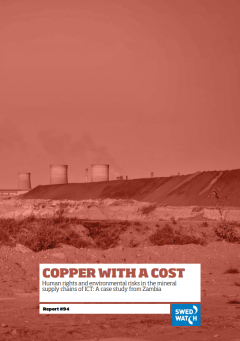Copper with a cost – Human rights and environmental risks in the minerals supply chains of ICT: A case study from Zambia
Report by Linda Scott Jakobsson for Swedwatch, published 6 May 2019.

Summary
'Unsustainable extraction of copper, a mineral frequently used in ICT products, has caused environmental degradation and adverse impacts on human rights in local communities in Zambia, a new Swedwatch report finds. Zambian mining projects have often been linked to adverse human rights impacts, particularly for communities located near the mining sites. Copper is used in a vast number of information and communication (ICT) products, and as Zambia is one of the largest copper producers in the world, there is a clear possibility that Zambian copper is found in today’s global ICT supply chains.
Swedwatch’s research in two of the country’s mining areas found that environmental pollution from copper mining impacted negatively on the right to clean water and health for community members in the Chingola district. In the district of Kalumbila, community members who had been relocated due to the establishment of a new mine claimed they were facing unemployment and had problems accessing markets where they could sell their crops. The report highlights the need for the ICT sector to address human rights risks in their sourcing of all high-risk minerals, in addition to conflict minerals and cobalt, and increase transparency in their copper supply chains.'
Disclaimer: This project is organised with the financial assistance of the European Union. The contents of this web page is the sole responsibility of the University of Edinburgh and can under no circumstances be regarded as reflecting the position of the European Union.
Some of the research reports shared on this website have been produced by the University of Edinburgh's partners on the EU-funded Make ICT Fair project. These reports do not reflect the views of the University of Edinburgh, and any queries regarding their content should be addressed to the authors identified within each report.

